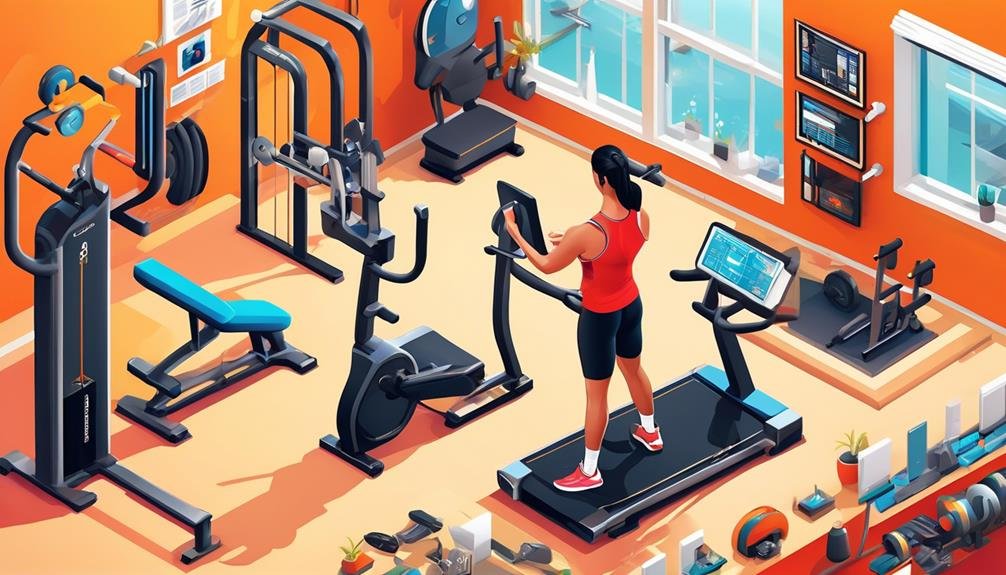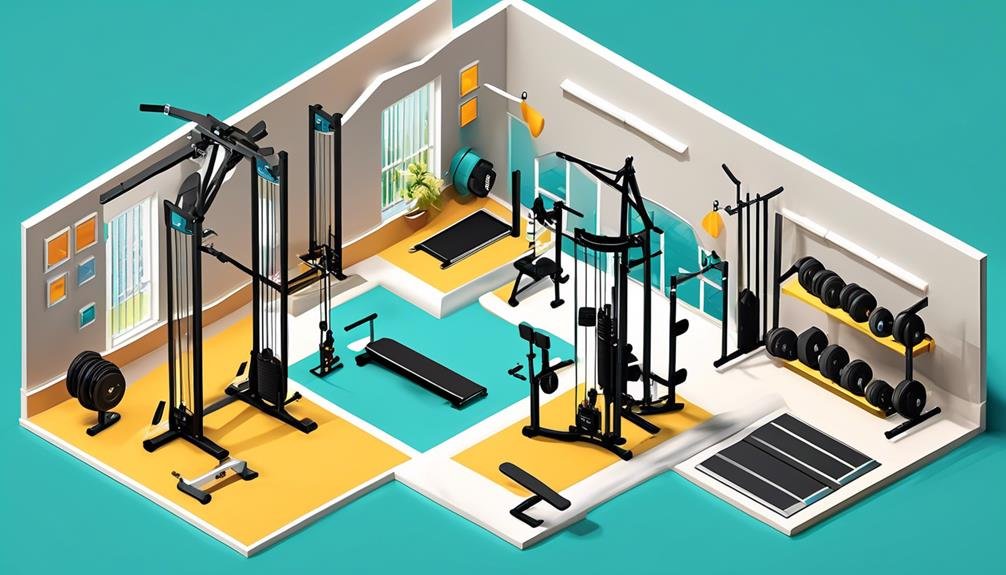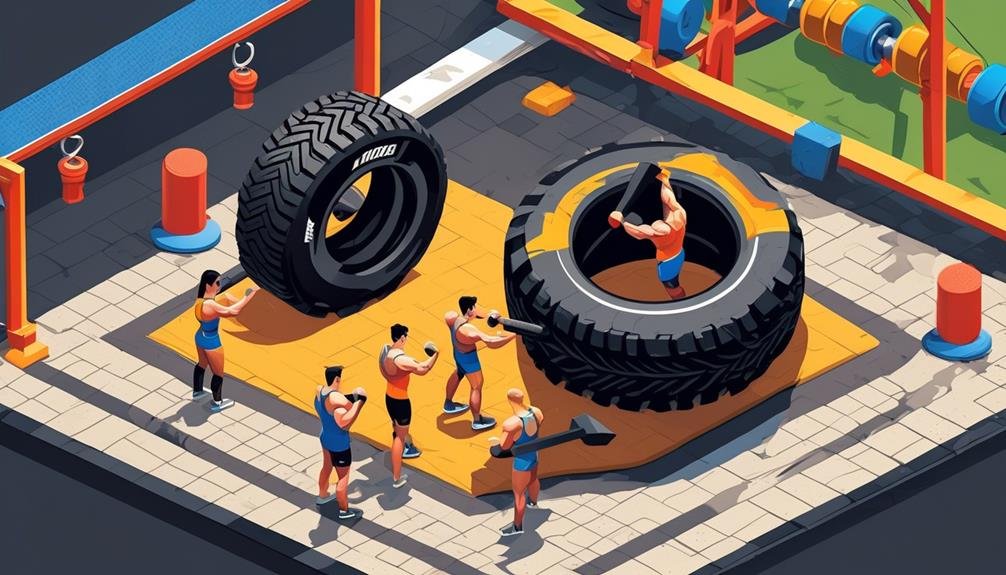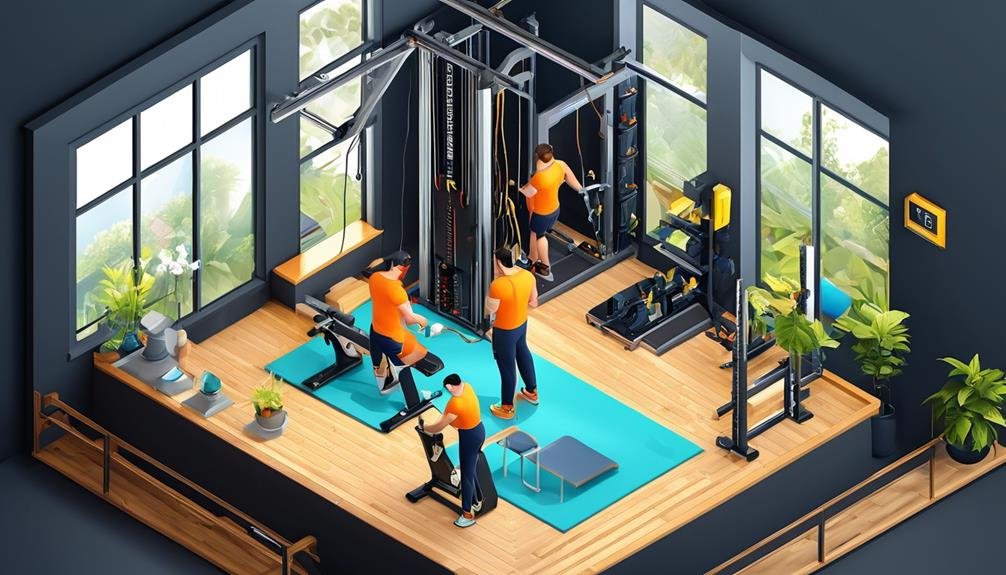Disclaimer: This content is for informational purposes only and does not replace professional medical advice, diagnosis, or treatment. Always consult a qualified healthcare provider before beginning any new exercise program.
Are you finding yourself in a situation where you need to familiarize yourself with new machines at the gym, but don't have the luxury of a personal trainer? It can certainly be a daunting task, but fear not!
There are effective strategies you can employ to navigate this challenge and ensure you make the most out of your gym experience. By following a few key steps, you'll be on your way to mastering those machines and reaching your fitness goals in no time.
So, let's get started and discover how you can conquer the art of learning new machines without a personal trainer.
Key Takeaways
- Utilize objective measurements and evaluations to assess your fitness level.
- Set clear goals by determining your ultimate fitness objective and breaking it into smaller, achievable milestones.
- Research and familiarize yourself with different machines by consulting fitness websites, instructional videos, or a fitness professional, and studying proper use and technique.
- Start with basic exercises such as squats, push-ups, lunges, plank, and dumbbell rows to build a foundation before using machines.
Assessing Your Fitness Level
To accurately assess your fitness level, it's essential to utilize objective measurements and evaluations. These tools provide valuable insights into your current physical condition and help you track your progress over time.
One of the most common methods used to assess fitness is the body composition analysis. This assessment measures your body fat percentage, muscle mass, and overall weight. It helps determine if you have a healthy body composition and if any changes need to be made.
Another important evaluation is the cardiovascular fitness test. This test measures your heart rate, blood pressure, and oxygen consumption during physical activity. It assesses how efficiently your heart and lungs are working and can indicate your overall cardiovascular health.
Strength and flexibility assessments are also crucial. These measurements evaluate your muscle strength and range of motion in different joints. They help identify areas of weakness or tightness that may need attention.
Lastly, don't forget about the functional fitness tests. These tests simulate everyday activities and assess your ability to perform them safely and effectively. They measure your balance, coordination, and agility.
Setting Clear Goals
Now that you have accurately assessed your fitness level, it's time to set clear goals to guide your progress. Setting goals will help you stay focused and motivated as you learn new machines without a personal trainer. Here are five key steps to help you set clear goals:
- Determine your ultimate fitness objective: Think about what you ultimately want to achieve with your fitness journey. Whether it's losing weight, gaining muscle, or improving overall strength and endurance, having a clear objective will give you direction.
- Break your goal into smaller, achievable milestones: To make your goals more manageable, break them down into smaller milestones. This will help you track your progress and celebrate accomplishments along the way.
- Set specific, measurable, and realistic targets: Make sure your goals are specific, measurable, and realistic. For example, instead of saying, 'I want to get stronger,' set a target like, 'I want to increase my bench press weight by 10 pounds in the next three months.'
- Create a timeline: Set a timeline for achieving your goals. Having a deadline will keep you accountable and prevent procrastination.
- Regularly reassess and adjust your goals: As you progress, it's important to reassess and adjust your goals. This will ensure that they remain challenging yet attainable.
Researching and Familiarizing Yourself With Different Machines

Before you begin using unfamiliar exercise machines, it is essential to research and familiarize yourself with their proper use and techniques. By understanding how each machine works and the correct form to use, you can maximize your workout and reduce the risk of injury. Researching different machines can be done through various sources such as fitness websites, instructional videos, or even consulting with a fitness professional. Familiarizing yourself with the machines can be achieved by visiting a gym or fitness center that has a wide range of equipment available. Take the time to study each machine's proper use and technique, and practice using them with light weights or no resistance to get a feel for the movements involved. To help you get started, here is a table outlining some common exercise machines and their primary muscle groups targeted:
| Machine | Primary Muscle Groups |
|---|---|
| Treadmill | Cardiovascular |
| Leg Press | Quadriceps, Hamstrings, Glutes |
| Lat Pulldown | Latissimus Dorsi, Biceps |
| Chest Press | Pectoralis Major, Triceps |
| Seated Row | Rhomboids, Biceps |
Starting With Basic Exercises
After familiarizing yourself with different exercise machines, it's time to start with basic exercises to build a strong foundation. These exercises will help you develop proper form, improve your strength, and prepare you for more complex movements. Here are five basic exercises you can start with:
- Squats: This compound exercise targets your lower body, including your quadriceps, hamstrings, and glutes. Start with bodyweight squats and gradually increase the resistance as you get stronger.
- Push-ups: A classic exercise that works your chest, shoulders, and triceps. Perform push-ups on the floor or modify them by using an incline or knee support if needed.
- Lunges: Another compound movement that strengthens your lower body, particularly the quadriceps, hamstrings, and glutes. Start with alternating forward lunges and progress to reverse or walking lunges.
- Plank: This exercise targets your core muscles, including your abs, back, and shoulders. Begin with a standard plank on your forearms and hold for 30 seconds, gradually increasing the duration as your core strength improves.
- Dumbbell Rows: This exercise focuses on your back muscles, specifically the lats and rhomboids. Start with a light dumbbell and row it towards your torso, keeping your back straight and squeezing your shoulder blades together.
Remember to warm up before each workout and listen to your body. Start with lighter weights and focus on proper form to avoid injury. As you become more comfortable with these exercises, you can gradually increase the intensity and add variations to keep challenging your body.
Utilizing Online Resources and Tutorials
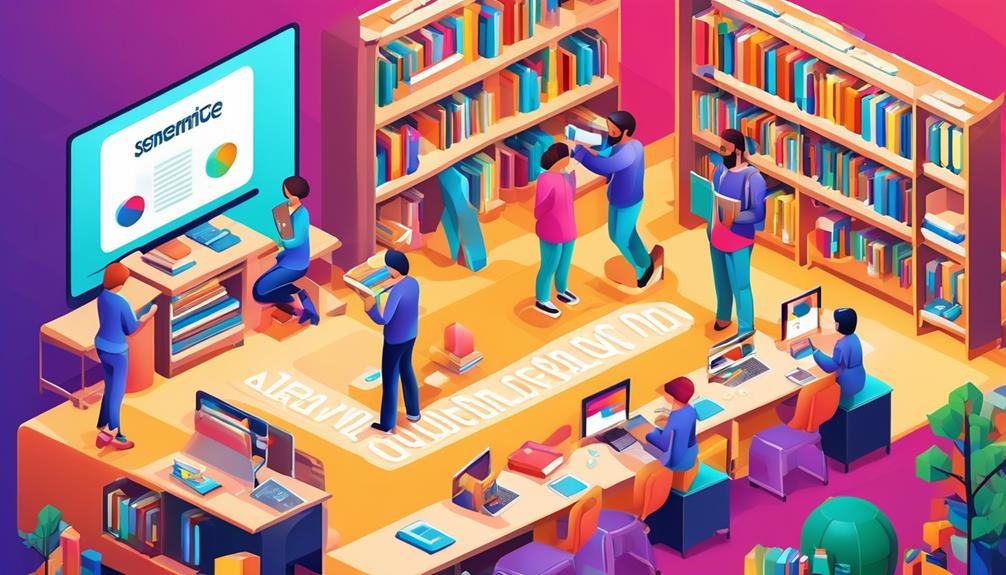
To make the most of your fitness journey, take advantage of the abundance of online resources and tutorials available to guide you along the way. The internet is a treasure trove of information, and when it comes to learning new machines, it can be your best friend. Whether you're a beginner or an experienced gym-goer, online resources can provide you with detailed instructions, demonstrations, and tips to help you master any machine.
One effective way to utilize online resources is by watching video tutorials. Many fitness experts and trainers create instructional videos that break down the proper form and technique for using different machines. These videos often include step-by-step instructions and demonstrations, allowing you to follow along and practice at your own pace.
Another valuable resource is online forums and communities dedicated to fitness. These platforms allow you to connect with like-minded individuals who can offer guidance and support. You can ask questions, seek advice, and even find workout routines specifically designed for certain machines. Additionally, many fitness websites and apps offer interactive diagrams and guides that explain how to use various machines correctly.
To give you an idea of the variety of online resources available, here's a table highlighting different types of platforms and their benefits:
| Platform | Benefits |
|---|---|
| YouTube | Video tutorials and demonstrations |
| Fitness forums | Community support and advice |
| Fitness websites and apps | Interactive diagrams and guides |
Observing Others at the Gym
One effective way to learn how to use new machines at the gym is by observing others. By watching experienced gym-goers, you can gain valuable insights and learn proper techniques. Here are five reasons why observing others at the gym can be beneficial:
- Technique: Watching others can help you understand the correct form and technique for using different machines. Seeing how others position their bodies and perform the exercises can prevent you from developing bad habits or risking injury.
- Variety: Observing others can expose you to different workout routines and exercises that you may not have considered. It can inspire you to try new things and diversify your own workouts.
- Confidence: Seeing others successfully use machines can boost your confidence and motivation. It helps you realize that you can do it too, and encourages you to push yourself to try new equipment.
- Etiquette: Observing others can also teach you about gym etiquette. You can learn how to properly share machines, clean up after yourself, and respect others' space, creating a positive gym environment.
- Inspiration: Watching others who are dedicated to their fitness goals can be inspiring. It can ignite your own determination to reach your fitness targets and keep you motivated on your fitness journey.
Asking for Help From Gym Staff or Fellow Gym-Goers
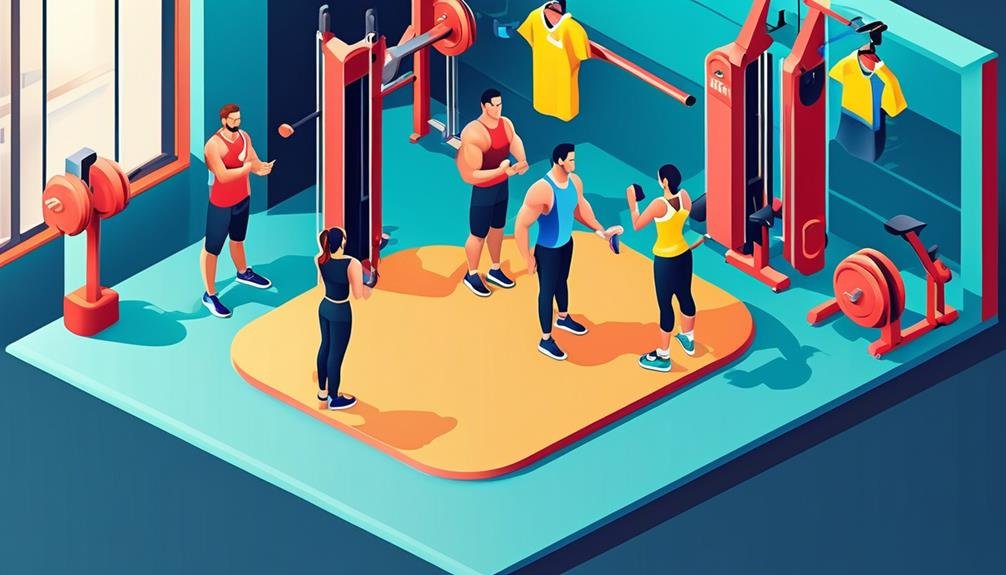
If you find yourself needing additional guidance or assistance with using new machines at the gym, don't hesitate to seek help from gym staff or fellow gym-goers.
Asking for help is a great way to learn how to use the machines correctly and avoid any potential injuries.
The gym staff are there to assist you and answer any questions you may have. They're knowledgeable about the equipment and can provide you with proper instructions on how to use each machine. Don't be afraid to approach them and ask for their guidance.
Fellow gym-goers can also be a valuable resource. Many experienced gym-goers are more than willing to help out a newcomer. They can offer tips and advice based on their own experiences. Just make sure to approach someone who looks approachable and friendly.
Tracking Progress and Adjusting Your Routine
Tracking your progress and adjusting your routine are essential for achieving your fitness goals. By keeping a record of your workouts and making necessary changes, you can maximize your results and stay motivated.
Here are some tips to help you effectively track your progress and adjust your routine:
- Set specific goals: Clearly define what you want to achieve, whether it's losing weight, gaining muscle, or improving endurance. Setting specific goals allows you to measure your progress accurately.
- Use a fitness tracking app: Utilize technology to track your workouts, monitor your heart rate, and calculate calories burned. Fitness tracking apps can provide valuable insights into your progress and help you make informed decisions.
- Keep a workout journal: Write down your exercises, sets, reps, and weights used during each session. This will enable you to track your strength gains and identify areas for improvement.
- Measure body composition: In addition to tracking weight, consider measuring body fat percentage and taking progress photos. These measurements provide a more comprehensive view of your progress.
- Regularly reassess your routine: Every few weeks, evaluate your workouts and make adjustments as needed. This could involve increasing weights, changing exercises, or modifying the number of sets and reps.
Frequently Asked Questions
What Are Some Common Mistakes to Avoid When Starting With Basic Exercises?
Starting with basic exercises can be intimidating, but avoiding common mistakes is key. Focus on proper form, start with lighter weights, and listen to your body. Consistency and patience will help you progress safely and effectively.
How Can I Effectively Track My Progress and Make Adjustments to My Routine?
To effectively track your progress and make adjustments to your routine, start by setting specific goals. Use a tracking app or journal to record your workouts, weights, and reps. Regularly review your progress and make necessary adjustments to keep challenging yourself.
Are There Any Specific Online Resources or Tutorials You Would Recommend for Learning About Different Machines?
There are plenty of online resources and tutorials available for learning about different machines. You can easily find videos, articles, and step-by-step guides that will help you understand how to use them effectively.
How Can I Overcome Any Fear or Anxiety About Asking for Help From Gym Staff or Fellow Gym-Goers?
To overcome fear or anxiety about asking for help from gym staff or fellow gym-goers, remind yourself that they are there to assist you. Approach them with confidence, explain your concerns, and ask for their guidance.
What Are Some Additional Tips for Staying Motivated and Consistent With My Fitness Routine?
To stay motivated and consistent with your fitness routine, set specific goals, create a schedule, find a workout buddy, vary your workouts, track your progress, reward yourself, and remember to have fun!
Conclusion
In conclusion, learning new machines at the gym without a personal trainer is possible with the right approach.
By assessing your fitness level, setting clear goals, researching and familiarizing yourself with different machines, starting with basic exercises, utilizing online resources and tutorials, observing others at the gym, asking for help from gym staff or fellow gym-goers, and tracking progress, you can effectively learn and incorporate new machines into your workout routine.
With determination and consistency, you can achieve your fitness goals and continue to progress in your fitness journey.
